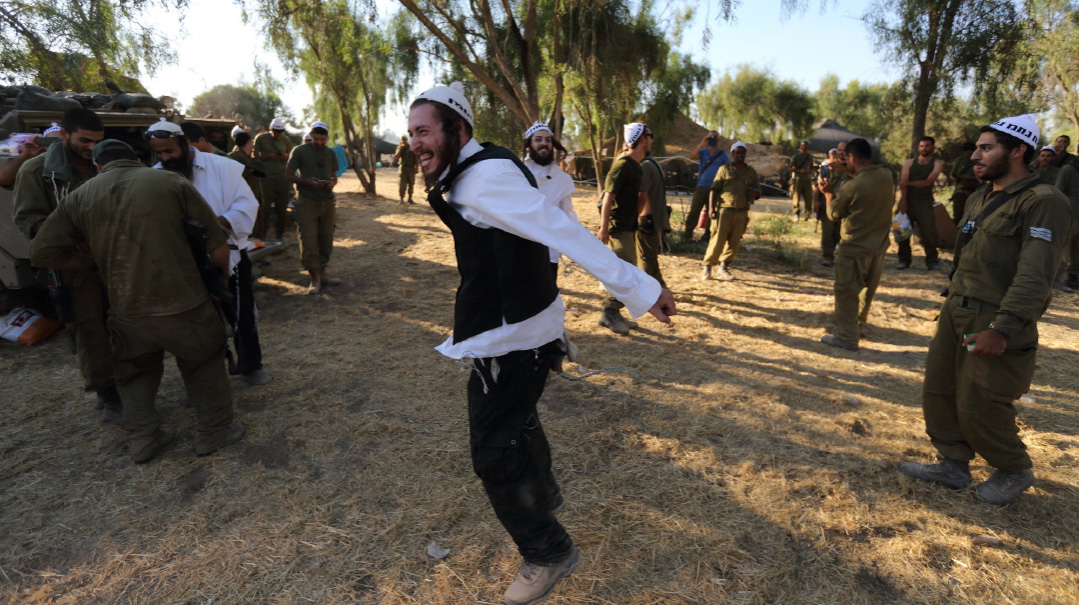The Chief Rabbi Hits It Out of the Park — Again

Rabbi Warren Goldstein has now published, as a companion volume to the Shabbos Project, Shabbat, A Day to Create Yourself
Rabbi Warren Goldstein did not step into an auspicious situation when he became chief rabbi of South Africa in 2005, in his early thirties. The South African Jewish community, which had once numbered 120,000, had shrunk to 75,000.
And the ever-present specter of violent crime was sending more and more Jews fleeing. Glenhazel, the Johannesburg neighborhood with the highest concentration of Jews, reported 20 crimes involving lethal weapons a month, and the actual number was likely close to twice that.
But the perpetually ebullient and optimistic new chief rabbi hardly seemed to notice the difficult situation into which he had been thrust, and he quickly discovered strengths of the South African community upon which to draw. Most prominent among them being the natural respect for authentic Torah and rabbanim held by the vast majority of South African Jews, almost all of whom are descendants of Lithuanian Jewish immigrants.
As Rabbi Akiva Tatz once explained to me: When the late Rabbi Mordechai Shakovitsky first walked onto Johannesburg’s University of Witwatersrand campus in search of Jewish souls, he did not seem out of place in his black frock and rabbinic garb. Virtually every student had a photo on the mantel of a recent ancestor who looked very similar.
Prior to Rabbi Goldstein’s induction, his rosh yeshivah, Rav Azriel Chaim Goldfein, a product of Telshe Yeshivah and long-time chavrusa of Rav Mordechai Gifter, enjoined him to be “a litvishe rav, leading your community and addressing its problems.” And that he did.
His first major initiative was the creation of Community Active Protection (CAP), initially in Johannesburg, in neighborhoods with a large Jewish population. CAP rapidly succeeded in bringing down the number of contact crimes in the neighborhoods covered from 130 a month to 12 a month. Having won the confidence of the community, the Chief Rabbi was able draw upon the deep wells of communal unity, as well as the considerable resources of the South African Jewish diaspora.
There followed the creation in 2011 of Sinai Indaba, which annually draws the most sought-after speakers and teachers in the Torah world to Johannesburg, Cape Town, and Durbin.
But it was the Shabbat Project, which first took place in South Africa in 2013, under the slogan “Keeping It Together,” that launched “the Chief’s” career as a major international Torah leader. Close to 70 percent of South African Jewry responded to the Chief Rabbi’s call to keep a full Shabbos, in all its halachic details. And of those who did, 90 percent expressed a desire to add more Shabbos observance to their lives.
That response would likely have been impossible in a less homogenous and tight-knit Jewish community. Most South African Jews have a family member or close friend who is shomer Shabbos, as a result of a teshuvah revolution in the ’70s. Approximately 25 percent of Johannesburg’s Jews fall into that category, probably the highest percentage of any large Jewish center in the world.
But word of what had happened in South Africa quickly spread (including in Mishpacha; see “Just One Shabbos,” Issue 481). Soon requests to participate from other countries began to pour into the Chief Rabbi’s office, and the Shabbos Project went international.
In 2015, Shabbos Project events were held in 918 cities in 84 countries. By 2019, the last year prior to the Covid pandemic, that number had grown to 1,600 cities in 100 countries. Typically, Shabbos was flanked by large Thursday night challah bakes — many of which attracted thousands of women — and Havdalah concerts attracting up to 20,000 Jews on Motzaei Shabbos.
The Shabbos Project revealed two crucial aspects about Jews today. The first was the latent desire of hundreds of thousands of Jews to connect to their traditions. In San Diego, for instance, 20,000 Jews participated in the Shabbos Project, even though only 17 percent of the community is affiliated in any way and only 3 percent is Orthodox.
Many of those experiencing Shabbos for the first time had never felt capable of doing so due to a lack of knowledge of what Shabbos observance entails. The Chief Rabbi’s team put out materials to guide them in multiple languages.
The second revelation was the power of the idea of Jews around the world joining together to keep Shabbos. Fifty members of the Gateshead community walked over an hour to join the Newcastle community, from which they are separated by the River Tyne and one hundred years of history, for Minchah and Shalosh Seudos.
A Jewish doctor in Sweden, living 150 miles from the nearest shul, kept Shabbos one year, and shortly thereafter moved to Stockholm to be part of a community. In Corsica, where there are no Jews listed in the population registry, forty turned up to keep Shabbos together. Three hundred Jews from Belarus celebrated Shabbos together in Pinsk, on short notice. For many of those, it was their first Jewish experience of any kind. At the end of Shabbos, three sets of parents registered their children for Jewish schools.
A grandmother living in the Nevada desert was asked by her granddaughter, “Bubby, are we the only Jews in the world?” She put out an invitation on social media and drew six Jewish families for Shabbos.
In Israel, the HaTzofim (Scouts) sent out thousands of volunteers to organize communal events and shabbatonim, And Shabbos meals were held on army bases around the country. At a Shabbos meal for 400, the secular mayor of Eilat proclaimed that the Shabbos Project is bringing “unity and holiness to Eilat.”
And all this activity was driven by thousands of volunteers around the world in their local communities, with such guidance and materials from the Chief Rabbi’s office as they needed.
THE SHABBOS PROJECT brought the experience of Shabbos to Jews around the world. But Chief Rabbi Goldstein felt from the inception that the experiential needed to be joined to a deeper understanding of the unique gift of Shabbos from HaKadosh Baruch Hu to the Jewish People (see Shabbos 10b). To that end, he has now published, as a companion volume to the Shabbos Project, Shabbat, A Day to Create Yourself: Building Character, Shaping Perspectives and Finding Happiness Through Shabbat.
The truth is that the Chief Rabbi had long had a manuscript of 25 essays on Shabbos prepared for publication. But somehow he did not feel the framework of separate essays was what was needed. The willingness to reexamine a manuscript and tear it up if necessary is one of the hallmarks of effective writers. And that is what Rabbi Goldstein did.
(He confided to me a couple of months ago that he is now doing the same thing with a nearly completed commentary on Pirkei Avos on the grounds that there is already a surfeit of such commentaries. Instead, he is developing a work on the worldview of Chazal based entirely on their words in Pirkei Avos.)
The two years spent reworking the material on Shabbos was time well spent. And I am confident that Shabbat, A Day to Create Yourself will soon be one of those works mostly likely to be found in Jewish homes worldwide — not only found but studied. (It has already been translated into Hebrew, French, and Spanish, and a Russian translation will soon be in the works.)
On the one hand, it is easily accessible to those without any background in Jewish learning. Most of the work’s 45 chapters are no more than three pages of text. There is no Hebrew in the text itself, and any Midrashic or other rabbinic material is fully translated. The text is a distillation of the deepest Torah thinkers on Shabbos.
At the same time, even the most learned reader will gain an enhanced appreciation for the gift of Shabbos. The end notes after each chapter are comprehensive. Besides the citations to Tanach, Midrash, Gemara, and the works of the Rishonim, the end notes single out the modern Jewish thinker whose insight animates each chapter — e.g., the Vilna Gaon, Rav Shamshon Raphael Hirsch, Rav Yerucham Levovitz, Rav Dessler, Rav Hutner, the Slonimer Rebbe, Rav Yosef Ber Soloveitchik, and the Lubavitcher Rebbe, to name a few.
My markings and comments are found on every page of the text in my copy. The book’s organizing insight was itself a new way of thinking about Shabbos, at least for me. Six days of the week are devoted to shaping the materials of the physical world around us. On Shabbos, our focus is on creating ourselves through refraining from the first type of creative activity.
Rabbi Goldstein follows the model of the Ramban in explicating taamei hamitzvos, as exemplified by his talmid, the anonymous author of Sefer Hachinuch. He demonstrates how Shabbos provides us with the means of developing our middos, which determine the extent to which we can grow and elevate ourselves spiritually (12 chapters), of shaping our perspectives on the world and our relationship with the Creator (16 chapters), and how it facilitates the joy required for a deep and lasting relationship with the Ribbono shel Olam and with those closest to us (nine chapters).
THE CHIEF RABBI is a thoroughgoing intellectual — his PhD thesis in law was subsequently published by Feldheim Publishers as Defending the Human Spirit: Jewish Law’s Vision for a Moral Society. And yet he never loses his practical focus on the task of disseminating Torah as widely as possible.
In that vein, he has secured generous support to make his sefer available to all those who want to learn more about Shabbos with a chavrusa or in a study group.
Because Shabbat, A Day to Create Yourself is shaveh l’kol nefesh, it is uniquely suited to being learned in chavrusas between observant and not-yet-observant Jews. After meeting with Rabbi Goldstein two months ago, I introduced him to Kesher Yehudi, an organization devoted to healing the rifts in Israeli society by creating deep, ongoing, one-on-one relationships between secular and religious Israelis based on their shared inheritance of Torah.
Mrs. Leah Hecht, the organization’s educational director, read the Hebrew translation of Rabbi Goldstein’s sefer overnight and immediately ordered 2,000 copies. The sefer was given out at the final meeting of each of the 27 pre-induction academies (mechinot) for idealistic, post-high-school Israeli youth taking a gap year prior to their entry into the IDF, with which Kesher Yehudi works. It is the perfect text for the 1,450 mechinistim and the Kesher Yehudi volunteers with whom they have been learning for hours every month over the past year and with whose families they have spent a Shabbos, to continue learning when the former enter the IDF.
At one of those final meetings, Mrs. Hecht observed a mechinah member excitedly snapping photos of pages from the book on her phone and sending them to her mother. Even though the young woman would be home that Shabbos, with her own copy of the sefer, she told Mrs. Hecht that what she was learning was too important to wait until Shabbos to share with her mother.
Mrs. Robin Meyerson, a one-woman kiruv dynamo operating out of Phoenix, is the director of the Shabbos Project’s North American operations (in addition to her work with Project Inspire, Partners in Torah Learning, and Rebbetzin Lori Palatnik’s Momentum program). She has already facilitated the establishment of 200 Shabbos Project learning groups in North America, and is almost out of the 5,000 copies of the sefer with which she began. (Any Mishpacha reader interested in establishing a learning group or chavrusa with non-shomer Shabbos friends or family should contact her at robin@chiefrabbi.co.za.)
Shabbat, A Day to Create Yourself responds to the call of the hour in Israel. The past four months of nonstop demonstrations against judicial reform have revealed divisions in Israeli society even deeper that previously imagined. Those divisions can only be overcome or mitigated by creating ongoing, personal relationships among those on both sides of the divide. Chief Rabbi Goldstein has provided a work around which such relationships can be built.
But all is not negative, either. A recent survey by the Jewish People Policy Institute found that 45 percent of Israel’s Jews define themselves as “traditional,” meaning that they make Kiddush on Leil Shabbos, light Shabbos candles, fast on Yom Kippur, and avoid chometz on Pesach. They have not cut themselves off from all Jewish observance and take pride in being Jewish. For them too, Shabbat, A Day to Create Yourself can only increase that pride and in many cases spur a new commitment to Shabbos observance. (Steimatsky’s, Israel’s largest chain of bookstores, is heavily promoting the work.)
The Chief has once again shown the ability to have a transformative impact on tens of thousands Jewish souls around the world.
(Originally featured in Mishpacha Jr., Issue 970)
Oops! We could not locate your form.







